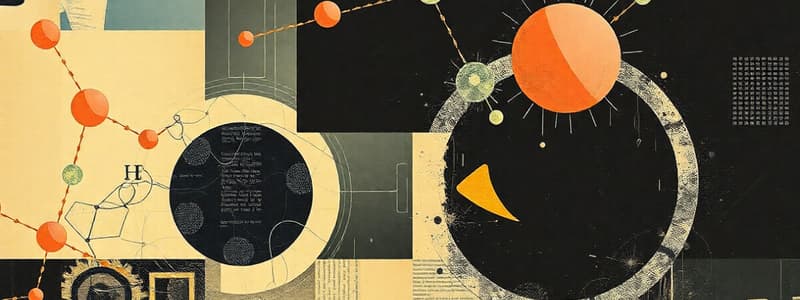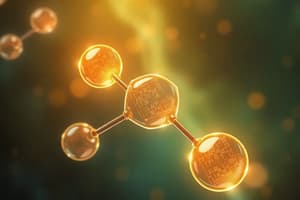Podcast
Questions and Answers
What is the general formula for mono-haloalkanes?
What is the general formula for mono-haloalkanes?
- C_nH_{2n-1}X
- C_nH_{2n+2}X
- C_nH_{2n+1}X (correct)
- C_nH_{2n}X
Which type of haloalkane has the halogen attached to a carbon that is connected to two other carbons?
Which type of haloalkane has the halogen attached to a carbon that is connected to two other carbons?
- Primary (1°)
- Tertiary (3°)
- Quaternary (4°)
- Secondary (2°) (correct)
What impacts the boiling points of haloalkanes compared to alkanes?
What impacts the boiling points of haloalkanes compared to alkanes?
- The number of hydrogen atoms
- The length of the carbon chain
- The number of halogen atoms
- Both A and C (correct)
Which of the following is a significant environmental concern associated with some haloalkanes?
Which of the following is a significant environmental concern associated with some haloalkanes?
What type of reaction do haloalkanes typically undergo to form alkenes?
What type of reaction do haloalkanes typically undergo to form alkenes?
Flashcards are hidden until you start studying
Study Notes
Haloalkanes
-
Definition: Haloalkanes (also known as alkyl halides) are organic compounds derived from alkanes by the replacement of one or more hydrogen atoms with halogen atoms (F, Cl, Br, I).
-
General Formula:
- For mono-haloalkanes: CnH(2n+1)X, where X is a halogen.
-
Types:
- Primary (1°): The carbon attached to the halogen is connected to one other carbon.
- Secondary (2°): The carbon is connected to two other carbons.
- Tertiary (3°): The carbon is attached to three other carbons.
-
Nomenclature:
- Named by identifying the longest carbon chain, then adding a prefix based on the halogen (e.g., chloro-, bromo-, iodo-) followed by "alkane".
- Example: 2-bromobutane.
-
Physical Properties:
- Polarity: Generally polar due to the electronegativity of halogens, affecting solubility.
- Boiling Points: Increase with molecular weight and number of halogen atoms; haloalkanes have higher boiling points than alkanes.
- State: Lower members are gases (e.g., CH3Cl), while higher members are liquids or solids.
-
Reactivity:
- Participate in nucleophilic substitution reactions (SN1 and SN2 mechanisms).
- Can undergo elimination reactions (dehydrohalogenation) to form alkenes.
-
Environmental Impact:
- Some haloalkanes (like chlorofluorocarbons - CFCs) are known to deplete ozone and contribute to greenhouse gas effects.
-
Uses:
- Solvents, refrigerants, agricultural pesticides, and in organic synthesis.
-
Safety and Toxicity:
- Many haloalkanes are toxic, carcinogenic, or harmful to aquatic life and should be handled with caution.
-
Testing:
- Can be identified through various methods including reaction with silver nitrate, leading to halide precipitate formation.
-
Conversion:
- Can be converted to alcohols, amines, and other functional groups through various reactions (e.g., hydrolysis).
Haloalkanes
- Haloalkanes are organic compounds where one or more hydrogen atoms in an alkane are replaced by halogen atoms (fluorine, chlorine, bromine, or iodine).
- Their general formula for mono-haloalkanes is CnH(2n+1)X, where X represents a halogen.
- Haloalkanes are classified based on the number of carbon atoms attached to the carbon bonded to the halogen:
- Primary (1°): One carbon atom is connected to the halogen-bearing carbon.
- Secondary (2°): Two carbon atoms are connected to the halogen-bearing carbon.
- Tertiary (3°): Three carbon atoms are connected to the halogen-bearing carbon.
- Nomenclature follows the pattern of identifying the longest carbon chain, then adding a prefix based on the halogen (e.g., chloro-, bromo-, iodo-) followed by "alkane".
- For instance, 2-bromobutane indicates a four-carbon chain with a bromine atom on the second carbon.
Physical Properties
- Haloalkanes exhibit polarity due to the electronegativity difference between the halogen atom and the carbon.
- This polarity affects their solubility, making them more soluble in polar solvents compared to alkanes.
- Their boiling points increase with increasing molecular weight and the number of halogen atoms.
- Haloalkanes generally have higher boiling points compared to alkanes due to stronger intermolecular forces.
- Lower molecular weight haloalkanes exist as gases (e.g., CH3Cl), while higher ones are liquids or solids.
Reactivity
- Haloalkanes undergo nucleophilic substitution reactions (SN1 and SN2 mechanisms), where the halogen is replaced by a nucleophile.
- They can also participate in elimination reactions (dehydrohalogenation), leading to the formation of alkenes.
Environmental Impact
- Some haloalkanes, particularly chlorofluorocarbons (CFCs), are known to deplete the ozone layer and contribute to greenhouse gas effects.
Uses
- Various applications of haloalkanes exist, including their use as solvents, refrigerants, agricultural pesticides, and in organic synthesis.
Safety and Toxicity
- Many haloalkanes are toxic, carcinogenic, or harmful to aquatic life.
- Therefore, handling and disposal of haloalkanes require caution.
Testing
- Haloalkanes can be identified using methods such as reaction with silver nitrate, which leads to the formation of a halide precipitate.
Conversion
- Haloalkanes can be converted to alcohols, amines, and other functional groups through various reactions, such as hydrolysis.
Studying That Suits You
Use AI to generate personalized quizzes and flashcards to suit your learning preferences.




